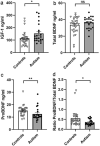BDNF, proBDNF and IGF-1 serum levels in naïve and medicated subjects with autism
- PMID: 35962006
- PMCID: PMC9374711
- DOI: 10.1038/s41598-022-17503-6
BDNF, proBDNF and IGF-1 serum levels in naïve and medicated subjects with autism
Abstract
Brain-derived neurotrophic factor (BDNF) and insulin-like growth factor 1 (IGF-1) promote the development and maintenance of neural circuits. Alterations in these factors might contribute to autism spectrum disorder (ASD). We asked whether serum BDNF, proBDNF, and IGF-1 levels are altered in an ASD population compared to controls. We measured serum BDNF, proBDNF, and IGF-1 immunoreactive protein in boys and girls aged 5-15 years old with mild to moderate ASD and non-autistic controls by ELISA. IGF-1 was increased in ASD serum compared to controls and was correlated with age and with CARS scores. Serum BDNF levels did not differ between groups, however, proBDNF serum levels were decreased in subjects with ASD compared to non-autistic controls. Medicated, but not unmedicated, ASD subjects exhibited lower serum proBDNF levels compared to controls, while neither IGF-1 nor BDNF levels differed between treatment groups. These data support the involvement of proBDNF and IGF-1 in the pathogenesis and treatment of autism.
© 2022. The Author(s).
Conflict of interest statement
The authors declare no competing interests.
Figures




Similar articles
-
Effect of non-invasive brain stimulation on behavior and serum brain-derived neurotrophic factor and insulin-like growth factor-1 levels in autistic patients.Drug Dev Res. 2021 Aug;82(5):716-723. doi: 10.1002/ddr.21808. Epub 2021 Mar 18. Drug Dev Res. 2021. PMID: 33734467
-
Brain derived neurotrophic factor (BDNF) and autism spectrum disorders (ASD) in childhood.Eur J Paediatr Neurol. 2015 Jul;19(4):411-4. doi: 10.1016/j.ejpn.2015.03.005. Epub 2015 Mar 18. Eur J Paediatr Neurol. 2015. PMID: 25847750
-
Serum levels of insulin-like growth factor-1 and insulin-like growth factor binding protein-3 in children with autism spectrum disorder.Zhongguo Dang Dai Er Ke Za Zhi. 2022 Feb 15;24(2):186-191. doi: 10.7499/j.issn.1008-8830.2110020. Zhongguo Dang Dai Er Ke Za Zhi. 2022. PMID: 35209985 Free PMC article. Chinese, English.
-
Neurotrophic Factors in Mouse Models of Autism Spectrum Disorder: Focus on BDNF and IGF-1.Adv Anat Embryol Cell Biol. 2017;224:121-134. doi: 10.1007/978-3-319-52498-6_7. Adv Anat Embryol Cell Biol. 2017. PMID: 28551754 Review.
-
Possible role of brain-derived neurotrophic factor (BDNF) in autism spectrum disorder: current status.J Coll Physicians Surg Pak. 2014 Apr;24(4):274-8. J Coll Physicians Surg Pak. 2014. PMID: 24709243 Review.
Cited by
-
The polymorphisms of candidate pharmacokinetic and pharmacodynamic genes and their pharmacogenetic impacts on the effectiveness of risperidone maintenance therapy among Saudi children with autism.Eur J Clin Pharmacol. 2024 Jun;80(6):869-890. doi: 10.1007/s00228-024-03658-w. Epub 2024 Feb 29. Eur J Clin Pharmacol. 2024. PMID: 38421437
-
Inhibiting proBDNF to mature BDNF conversion leads to ASD-like phenotypes in vivo.Mol Psychiatry. 2024 Nov;29(11):3462-3474. doi: 10.1038/s41380-024-02595-5. Epub 2024 May 18. Mol Psychiatry. 2024. PMID: 38762692
-
The Ambiguous Role of Growth Factors in Autism: What Do We Really Know?Int J Mol Sci. 2025 Feb 13;26(4):1607. doi: 10.3390/ijms26041607. Int J Mol Sci. 2025. PMID: 40004071 Free PMC article. Review.
-
mTOR Signaling Disruption and Its Association with the Development of Autism Spectrum Disorder.Molecules. 2023 Feb 16;28(4):1889. doi: 10.3390/molecules28041889. Molecules. 2023. PMID: 36838876 Free PMC article. Review.
-
The Insulin-like Growth Factor Family as a Potential Peripheral Biomarker in Psychiatric Disorders: A Systematic Review.Int J Mol Sci. 2025 Mar 12;26(6):2561. doi: 10.3390/ijms26062561. Int J Mol Sci. 2025. PMID: 40141202 Free PMC article.
References
-
- Asken MJ, Grossman D, Christensen LW. Diagnostic and Statistical Manual of Mental Disorders. 5. American Psychiatric Publishing; 2013.
-
- Fahnestock M, Nicolini C. Bridging the gap between genes and behaviour: Brain-derived neurotrophic factor and the mTOR pathway in idiopathic autism. Autism-Open Access. 2015;5:143. doi: 10.4172/2165-7890.1000143. - DOI
MeSH terms
Substances
LinkOut - more resources
Full Text Sources
Medical
Miscellaneous

